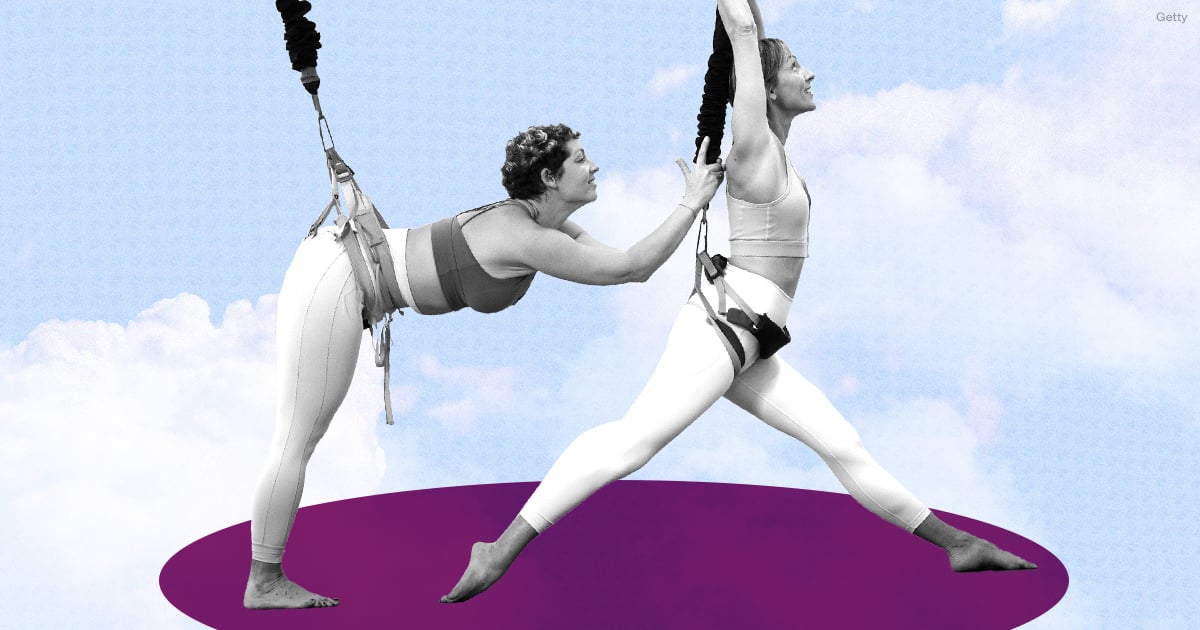In the latest problematic thing happening on the internet: middle-aged women are getting shamed for the ways they’re choosing to move their bodies. TikTokers are capturing these women doing a variety of nontraditional workouts (think: cardio drumming, trampolining, aerial bungee, or working out in Moon Boots). The videos then poke fun at these women, for “doing anything but a normal workout,” “doing anything to not lift weights,” “doing three sets of tomfoolery,” etc.
Unfortunately, shaming middle-aged women, or shaming people for how they choose to move their bodies, is nothing new. But what these shamers are ignoring is the fact that these workouts have benefits, some that go way beyond the traditional definition of fitness.
Christopher Gagliardi, ACE-certified personal trainer and health coach, shares that the American Council on Exercise has done research that supports some of these workouts as effective forms of exercise. Cardio drumming has been proved effective in terms of enjoyment, caloric expenditure, and producing an elevated heart rate for cardiorespiratory benefits. Trampoline workouts offer the same energy expenditure as running 6 miles per hour on flat ground or biking at 14 miles per hour, at a much lower impact.
“While we haven’t studied all of these methods, as long as the exercise method is safe, doing some physical activity is always better than doing none,” says Gargliardi. The physical activity guidelines for Americans recommend that adults perform 150-300 minutes of moderate-intensity aerobic physical activity per week, or 75-150 minutes of vigorous intensity aerobic activity per week (or an equivalent combination of both each week). If you can achieve these target levels of intensity from a workout, then you can obtain health benefits from it, Gagliardi says, no matter how “silly” it might look or feel. As a rule of thumb, a person doing moderate-intensity aerobic activity can talk, but not sing, during the activity. A person doing vigorous-intensity activity cannot say more than a few words without pausing for a breath.
Ultimately, these “middle-aged workouts” have traditional cardiovascular health benefits and are nothing to poke fun at. But they also do much more than meeting general physical activity guidelines. The reasons why we work out are highly personal, and unique to each person, says Gagliardi. “For some people, the health benefits may be most important; for others, it’s maintaining weight, and for others, it might be social connection. The results you should strive for are the ones that are personally meaningful for you and that align with your values.”
Critics of these workouts are ignoring the fact that not everybody has the same fitness goals. Many of the critiques center around the idea that “middle-aged women will do anything not to lift a weight.” While strength training does have proven benefits, it’s not a workout that works for everyone, and as Gagliardi and the science will tell you, any movement is better than no movement. Additionally, group fitness classes like these can not only accomplish the same benefits as working out solo, but can also offer the additional benefit of social connection, says Gagliardi. Group fitness has been shown to influence perceptions of exertion, recalled enjoyment and pleasure, and feelings of “groupness,” all of which can positively impact how long somebody sticks with the exercise.
Women, on average, tend to exercise less than men; but interestingly, they can see better results from the same amount of exercise. That’s why it’s so important to get this group in the gym, however they choose to do it. For these women, the community and fun of these workouts may matter more than the physical results; but ultimately, their motivations aren’t our business, nor the business of anyone else on the internet. They’re working out, and they’re having a good time doing it. What more can you ask for than that?
Thankfully, these workouts have online defenders in addition to haters: Tommy Martin, MD, has commented on the unfair, unkind, and unnecessary critique of these workouts. “Everybody’s version of exercise is different,” he says in his response video. “We are all at different fitness levels… For [some people], going to this class and doing any movement is a huge improvement.” He mentions that exercise has myriad benefits beyond just fitness: it has been shown to decrease anxiety and depression, and to improve body image, sleep, bone density, and even academic performance. Lastly, he says, we don’t know these women’s backgrounds, health status, or physical limitations. So rather than judging, try strapping on the moon boots or bungee harness – you might find that you have not only a great workout, but a great time.
Kaley Rohlinger is a freelance writer for PS who focuses on health, fitness, food, and lifestyle content. She has a background in the marketing and communications industry and has written for PS for over four years.




